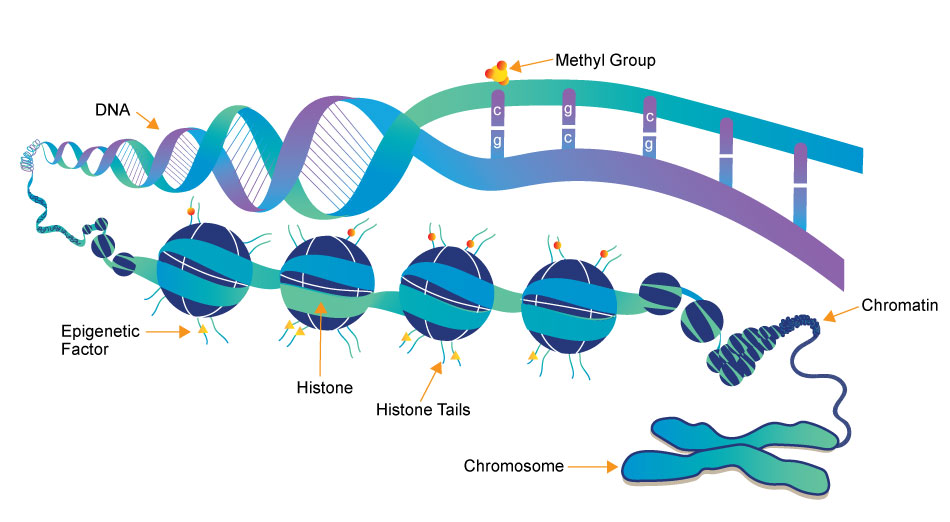Epigenetics


Epigenetics research delves into the molecular mechanisms that control gene expression and cellular traits without altering the underlying DNA sequence. One crucial aspect of this field is the role of small molecules, which act as powerful regulators of epigenetic modifications. These small compounds, typically comprising a few dozen to a few hundred atoms, have emerged as essential tools in understanding and manipulating the epigenome.
- DNA Methylation Inhibitors: Small molecules like 5-azacytidine and 5-aza-2'-deoxycytidine are DNA methyltransferase inhibitors. They block the addition of methyl groups to DNA, leading to DNA demethylation. This can reactivate silenced genes, potentially offering therapeutic avenues for conditions like cancer.
- HDAC inhibitors: HDACs remove acetyl groups from histone proteins, contributing to gene repression. Small molecule HDAC inhibitors, such as Vorinostat and Romidepsin, can reverse this process by increasing histone acetylation, allowing genes to be more accessible for transcription. These inhibitors are being explored for cancer therapy and other conditions.
- Histone Methyltransferase Inhibitors: Small molecules like GSK126 inhibit specific histone methyltransferases, affecting histone methylation patterns. This can alter gene expression, making them promising candidates for cancer and other diseases with epigenetic dysregulation.
- RNA Modulators: Small molecules can also target non-coding RNAs involved in epigenetic regulation. For instance, small molecules called small interfering RNAs (siRNAs) can be designed to target and degrade specific long non-coding RNAs, influencing gene expression.
- Epigenetic Reader Domain Inhibitors: These small molecules target proteins that recognize and bind to specific epigenetic marks. Examples include inhibitors of bromodomain-containing proteins (BET inhibitors), which can disrupt gene regulation by interfering with protein-DNA interactions.
Small molecules in epigenetics research not only provide insights into the fundamental biology of gene regulation but also hold immense promise for developing novel therapeutics. Their ability to selectively modulate specific epigenetic marks and pathways has led to ongoing clinical trials and drug development efforts for various diseases, including cancer, neurological disorders, and inflammatory conditions. Understanding and harnessing the power of these small molecules is at the forefront of modern epigenetics research, offering new hope for precision medicine and targeted therapies.
3 key components involved in the regulation of epigenetic modifications
Epigenetics Writer
Epigenetics writers are enzymes responsible for adding chemical marks or modifications to DNA or histone proteins. These marks include DNA methylation (addition of methyl groups to DNA) and histone modifications (such as acetylation, methylation, phosphorylation, etc.).
Epigenetics Reader
Function: Epigenetics readers are proteins that can recognize and bind to specific epigenetic marks on DNA or histones. These reader proteins interpret the epigenetic code and facilitate downstream cellular processes, such as gene activation or repression.
Epigenetics Eraser
Function: Epigenetics erasers are enzymes responsible for removing or reversing epigenetic marks on DNA or histones. This process allows for the dynamic regulation of gene expression and the resetting of epigenetic states during various stages of development and in response to environmental changes.
-
p32-kinase activator
D-erythro-鞘氨醇(红鞘氨醇)是一种非常有效的p32-激酶激活剂,其EC50为8μM,并且能够抑制蛋白激酶C(PKC)。D-erythro-鞘氨醇(红鞘氨醇)也是PP2A的激活剂。 -
PKC activator
(-)-Indolactam V 是一种蛋白激酶C激活剂,它强烈地将来源于人类胚胎干细胞的确定性内胚层引导成胰腺内胚层。- Manuel Mendoza, .et al. , Tetrahedron, 2019, May
-
PKC activator
12-O-四十碳酰基山麻杆-13-醋酸酯是山麻杆的二酯,是从巴豆油中提取的肿瘤促进化合物。它是一种可逆的、高效的蛋白激酶C(PKC)激活剂,在体外和体内的纳摩尔浓度下具有高效活性。- Ping Li, .et al. , J Ovarian Res, 2024, Sep 17;17(1):188 PMID: 39289738
-
PKC activator
Phorbol 12,13-二丁酸酯(Phorbol dibutyrate)是一种PKC激活剂并且是一种强效的皮肤肿瘤促进剂。 -
PKC activating agent
Decursinol angelate,一种来自紫当归(Angelica gigas)根部的细胞毒性和蛋白激酶C(PKC)激活剂,具有抗肿瘤和抗炎活性。




